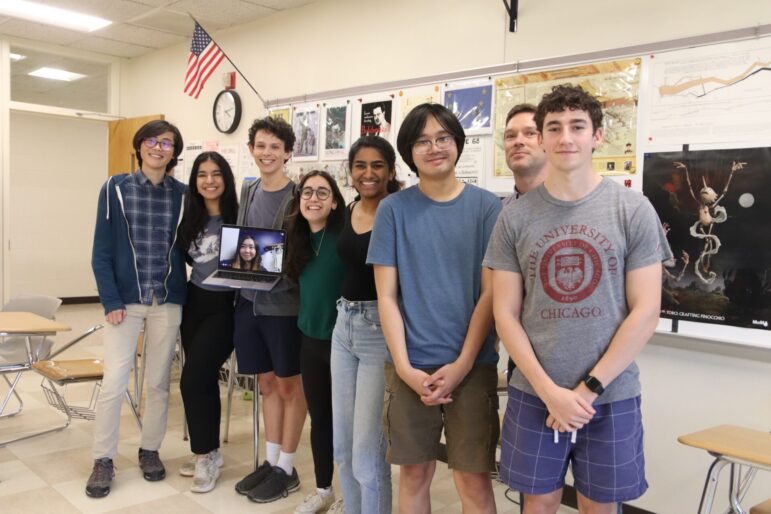By Victoria Liu, Greenwich High School class of 2023
The Greenwich High School Econ Club Econ Club’s entry in the New York Federal Reserve Challenge has been selected for publication.
The team is composed of Elliott Gordon, Ambika Grover, Ryan Kaufman, Cindy Li, Maximilian Lu, Charles Andrew Miranda, Amrutha Nandakumar, and Nicole Orlofsky, and advised by GHS social studies teacher Ian Tiedemann.
The team was one of 12 winning teams in the 2023 New York Federal Reserve Challenge, with around 70 teams participating from New York state, parts of New Jersey, Fairfield County, and Puerto Rico. The 2022-2023 theme was “Economics of Globalization”.

For the competition, the GHS team wrote a podcast script titled “It’s a (s)Mall World: Globalization, E-Commerce, and Shopping Malls,” which focuses on the rise of e-commerce and its effect on shopping malls. Their script will be published in the Federal Reserve Bank of New York’s Journal of Future Economists.
Initially, the team members noticed how local malls had changed drastically in the last few years.
“We talked about how the [Stamford Mall] started out; it was very much a boon to the community… now it’s this absolutely desolate space,” Nicole said.
The demise of the shopping mall can be attributed to the rapid rise in e-commerce and the Age of the Internet.
“Supply chains are now becoming increasingly connected and we can create goods much more cheaply. This Age of the Internet has meant that more people than ever have access to smartphones, and any business can put their things online. That has had a trickle-down effect on malls,” Ambika said.
Additionally, in the Digital Age, malls are no longer a place for easy access to goods and services that are unavailable nearby.
“Malls used to serve as a middle-man in transactions where you had to go to a mall to purchase goods that were not available at a local store,” Ryan explained. “We showed this correlation between the success of retail-based malls and how they start to falter when the use of e-commerce rises in a country.”
As a result, shopping malls have slowly shifted their focus away from solely retail. Moreover, malls are taking advantage of the industries that are less digitized to attract customers.
“For example, food is still primarily bought and sold in physical locations,” Ryan said. “Certain malls are trying to transition towards becoming food courts to attract more people. They’re also leaning into the more community-hub aspect by having more forms of entertainment.”
Nearby, the Stamford Town Center is starting to adapt as well.
“They’re going to be putting games and hubs of social activity in there, not just retail space to revitalize what once was,” Elliott said.
The team also talked about how malls are again fulfilling their purpose as community gathering spaces.
“There is still a need for spaces for people to congregate outside the home,” Amrutha said. “The purpose of having a physical space to exist freely still exists, and the malls are going to start serving that purpose more and more.”
The team talked about “creative destruction” of malls, which is the process of innovation and technological change that leads to the destruction of existing economic structures.(1)
“As there are a lot of malls that are sitting empty right now, there’s going to have to be fewer malls because there’s an over-saturation right now. Those fewer malls are going to be of higher quality, and they’re going to adapt. That’s part of the process of creative destruction,” Max said.
The topic of the rise of e-commerce and the decline of malls relates to globalization in the sense that the rise and fall of malls seem to operate on a different timeline in different countries.
“Countries around the world are exploring malls differently. In countries like Singapore, for example, malls still have that charm,” Ambika said. “People go there—it’s a hub, a centerpiece. Exploring the different rates that globalization has impacted malls was another thing we took a look at.”
“Some countries are not as far advanced with e-commerce as the US, so they might be going into the whole mall-boom now, whereas we did around 50 years ago,” Charles said.
The Fed challenge has given members of the GHS team the ability to see economic concepts play out in the real world and has helped them better understand current events.
Lastly, the team members acknowledged GHS Economics Club Advisor Mr. Tiedemann’s passion and enthusiasm for the effort.
“He’s been so helpful with helping us organize,” Ambika said. “Sending us articles to read about malls and steering us in the right direction. All of this and anything we do in the Economics Club comes from him.”
(1) Creative Destruction: Out With the Old, in With the New